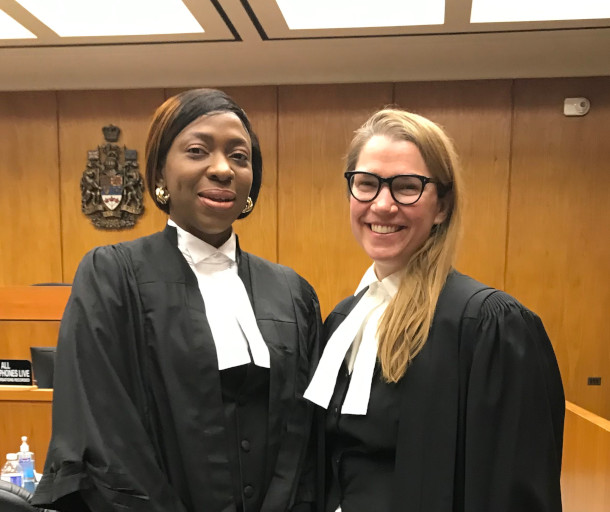Prof. Anna Lund and embedded housing researcher help people facing foreclosure
Benjamin Lof - 6 December 2023

People dealing with the threat of foreclosure on their homes have a new resource to call on, stemming from research by Associate Professor Anna Lund of the University of Alberta Faculty of Law.
Earlier this year, Lund was awarded a Partnership Engage Grant from the Social Sciences and Humanities Research Council of Canada for her project to hire an "Embedded Housing Researcher" at the Edmonton Community Legal Centre (ECLC).
Lund and ECLC selected Ebun Agharese, an internationally trained lawyer from Nigeria, to pilot this unique articling position dedicated to delivering legal services to low-income individuals across Alberta while helping conduct research on residential foreclosures.
“I’ve been volunteering as a lawyer at ECLC for over a decade,” says Lund. “In that time, I’ve met with many homeowners facing foreclosure. This research project have given me the opportunity to deepen my own knowledge in the area and start to examine, more systematically, the types of legal issues that are coming up for people.”
The project, which began in February, aims to produce novel legal scholarship, build capacity in Alberta legal clinics, and inform legal advocacy and reform initiatives on foreclosure law.
One specific goal is to ensure homeowners facing foreclosure are able to take advantage of the existing legal protections.
The first few months involved gathering data on foreclosure matters since 2018 from the ECLC database, including information from their Consumer Debt Negotiation Project.
“We noted that a lot of people, especially first-time owners, didn’t know there were two types of mortgages in the first place, or what will happen if they don’t pay their mortgage on time.” says Agharese. “For many people, all they know is that they paid five percent.”
“We decided to write something to help people understand the type of mortgages they have.”
The result was “High Ratio vs. Conventional Mortgages,” an article written by Lund and Agharese that came out in September for LawNow, an online publication which aims to make the law more accessible to non-lawyers and is published by Centre for Public Legal Education Alberta.
The article explains the importance of knowing what type of mortgage you have in Alberta— high ratio/insured or conventional—as this affects the amount of time you have to stop a foreclosure (the redemption period) and also whether the Court can grant a deficiency judgment against you (i.e., do you have to pay money to the lender if your property is worth less than the amount owing on the mortgage).
A high ratio, insured mortgage is required when the bank is loaning more than 80 percent of a home’s value. Contrary to how ‘insured’ is usually understood, the borrower pays to insure the bank, and not themselves, against any losses.
The article provides details on how to determine what type of mortgage you have, gives a primer on what deficiency judgements and redemption periods mean, and lists how to get further help, including options for low-income individuals
In addition to its online version, the article is now included in information sessions put on by the intake team at ECLC for people facing foreclosure.
“Recently, a lot of people [facing foreclosure] have come to the clinic upset and not knowing what to do when a statement of claim has been served on them or they get a demand letter” Agharese says. “They don’t know that they could potentially pay within six months, or anything about the redemption period, and this article has really been able to help them.”
Lund and Agharese will continue their collaborative research on foreclosure law into next year.